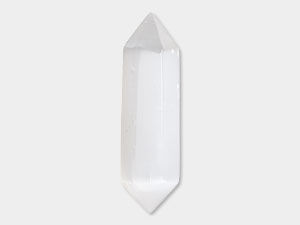Selenite Meaning and Properties
Selenite History
Selenite is a specific variety of the mineral gypsum named after the Ancient Greek goddess of the moon, Selene. The Greeks especially appreciated the beauty of selenite, even making windows with the stone. This gemstone received its official name from J.G. Wallerius in 1747 when he wrote Mineralogia, eller Mineralriket.
Gypsum as a general material has been valued since as far back as the Egyptians where it was used for decorative purposes. One unique use of selenite is in the Santa Sabina church in Rome: the large arched windows (built in the 5th century) are made of sheets of selenite, not glass. After large amounts of gypsum were found near Paris, France, a material known as Plaster of Paris was created. Plaster of Paris is gypsum that has been chemically altered to extract the water within. It's also said French farmers used raw gypsum as a soil additive.
Discover its fascinating history, explore its powerful metaphysical properties—like cleansing energy and promoting clarity—and learn about its unique physical characteristics. Plus, follow along with an easy pendant and earring project featuring selenite to start creating with this meaningful gemstone.

Selenite Metaphysical Properties
The gemstone selenite is most closely associated with the crown chakra, which represents wisdom and spirituality, as well as the third eye chakra. The colorless beauty and translucency of selenite is often attributed to purity and peace in both metaphysical beliefs and color theory. Selenite is excellent to use when meditating or trying to achieve mental clarity, as it is believed to compel the person holding it to be honest with themselves.
Selenite is considered a high-energy crystal that vibrates at a high frequency. Despite being an incredibly soft stone, so soft a fingernail can scratch it, selenite gemstones are believed to be a stone of protection that wards the mind. It is commonly used by crystal practitioners as a way to cleanse the body, mind and spirit of negativity and self-limitation--as well as cleansing other gemstones being used in healing practices.
Selenite is not a traditional birthstone, but is associated with the zodiac sign of Cancer.
Selenite Geological Properties
There are four varieties of gypsum that are often lumped together under the term selenite: selenite, satin spar, desert rose and gypsum flower. Most commonly, selenite forms as white, translucent crystals with striations and a vitreous luster. Selenite forms in enormous deposits and beds of sedimentary rocks such as limestone or in clay. There have been instances of selenite forming in igneous rock. The mineral selenite can be found all over the world, but is most often found in Mexico, Poland, Russia, Greece, Japan, Australia, Argentina, Brazil and the United States.
- Mineral Information: Hydrous calcium sulfate
- Chemical Composition: CaSO4 · 2H2O
- Color: Colorless, white, gray, brown, beige, orange, pink, yellow, light red, green
- Hardness: 2 (Mohs)
- Specific Gravity: 2.3 - 2.4
- Refractive Index: 1.5
Proper Care of Selenite
Selenite is a delicate stone that should be handled with care. When not wearing selenite jewelry, store it away from other stones and materials in a soft fabric bag to prevent scratching. To clean selenite, simply use a soft cloth free of impregnations. Selenite is water soluble, so it's recommended to avoid submersing or rinsing your stone in water. For this same reason, it is suggested to not use cleaners or polishes. Remove selenite jewelry before participating in sports or other activities that can cause perspiration. Keep selenite out of direct prolonged sunlight, as this exposure can cause loss of luster.
Designing with Selenite
Selenite gemstones are the perfect addition to any jewelry palette. Need an angelic-looking stone for Christmas jewelry? Use selenite alongside brilliant greens like emerald and garnet reds. Need a muted white gemstone for bridal jewelry? Try selenite accompanied by pearls, mother-of-pearl shell and other softly iridescent materials. Looking to create a sophisticated piece of jewelry for evening wear? Selenite seems to glow next to the deep blackness of jet and dyed onyx. Smooth selenite gemstones create textural intrigue when paired with rougher materials such as matte lava rock or shiny druzy formations. There really isn't anything selenite can't do in jewelry-making.
Shop for Selenite
**Please note that all metaphysical or healing properties listed are collected from various sources. This information is offered as a service and not meant to treat medical conditions. Fire Mountain Gems and Beads® does not guarantee the validity of any of these statements.
How did you like this resource? Your feedback helps us provide resources that matter to you most.
Copyright Permissions
All works of authorship (articles, videos, tutorials and other creative works) are from the Fire Mountain Gems and Beads® Collection, and permission to copy is granted for non-commercial educational purposes only. All other reproduction requires written permission. For more information, please email copyrightpermission@firemtn.com.


